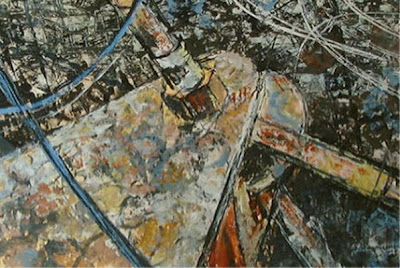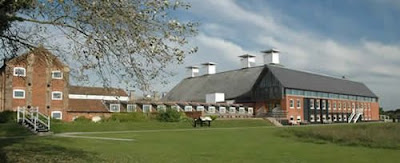Music will rise from the wreckage.....
 Steel works, Snape Maltings fire: mixed media by Cavendish Morton linked from Island Arts
Steel works, Snape Maltings fire: mixed media by Cavendish Morton linked from Island Arts It was a dark night, but as we came over the brow of the hill the sky was lit up by an orange glow, with a trial of thick smoke. If this was dramatic, seen from close to it was positively theatrical. Above our heads the black shell of the Maltings loomed like the flank of a stricken liner..... In the foreground, silhouetted against the bright lights, members of the English Opera Group chorus were collapsing into each other's arms. It was a devastating event, of course, but one whose aftermath - the triumphant rescue of the Idomeneo premiere at Blythburgh, and the Maltings rebuilding for the very next Festival - swiftly became part of the Aldeburgh legend.
In 1965 the expanding Aldeburgh Festival urgently needed a purpose built concert hall. After much searching Benjamin Britten and Peter Pears found a disused maltings at Snape on
 the River Alde four miles upstream from Aldeburgh. Architects Arup Associates were commissioned to oversee the conversion of the old agricultural building into a state of the art auditorium. The new hall was opened by Her Majesty The Queen in June 1967 (photo right) to universal acclaim, both for its outstanding acoustics and sympathetic conversion.
the River Alde four miles upstream from Aldeburgh. Architects Arup Associates were commissioned to oversee the conversion of the old agricultural building into a state of the art auditorium. The new hall was opened by Her Majesty The Queen in June 1967 (photo right) to universal acclaim, both for its outstanding acoustics and sympathetic conversion.The opening concert of the 1969 season was an afternoon performance of Schubert's Trout by Britten and the Amadeus Quartet. During the evening fire broke out beneath the stage and quickly spread to the whole hall, resulting in the conflagration described above by an eyewitness, the pianist and accompanist Roger Vignoles. (The quote is from Autograph Books excellent Time & Concord - Aldeburgh Festival Recollections).
 The fire completely destroyed the roof, stage, seating, and flooring. All that remained of the main building were the structural walls which were damaged but still standing. (The photo to the right shows Britten and Pears standing in the wreckage). As serious as the structural damage was the artistic loss was even greater. Two of the precious instruments used in the Trout were burnt beyond recognition - Britten's own Steinway concert grand, and cellist Adrian Beer's priceless Grancino double-bass. Adrain Beer heart-wrenchingly describes how all he found were "some ashes and metal parts of that lovely instrument." Also totally lost were the costumes for the new production of Idomeneo that was to be premiered by Britten's English Opera Group in the Maltings three days later.
The fire completely destroyed the roof, stage, seating, and flooring. All that remained of the main building were the structural walls which were damaged but still standing. (The photo to the right shows Britten and Pears standing in the wreckage). As serious as the structural damage was the artistic loss was even greater. Two of the precious instruments used in the Trout were burnt beyond recognition - Britten's own Steinway concert grand, and cellist Adrian Beer's priceless Grancino double-bass. Adrain Beer heart-wrenchingly describes how all he found were "some ashes and metal parts of that lovely instrument." Also totally lost were the costumes for the new production of Idomeneo that was to be premiered by Britten's English Opera Group in the Maltings three days later.Through superhuman efforts by Britten, Pears and the Festival committee, Idomeno was transferred to a hastily constructed stage in Blythburgh Church. Costumes were borrowed from the London opera houses, and the premiere went ahead to critical acclaim. Of the other eighteen performances in the 1969 Festival only one was lost, the others all took place in alternative venues.
As if all that work was not enough, on the day following the devastating fire Britten and Pears started planning the rebuilding of the gutted Maltings. Miraculously this herculean task was completed for the first concert of the following season. On 2nd June 1970 the Queen returned to re-open the Maltings (and reportedly said she hoped not to be invited back for a third time). The rebuilt hall that rose phoenix-like from the wreckage proved to have acoustics identical to the original. (In fact some claimed the acoustics of the rebuilt auditorium were superior as Britten had authorised subtle changes).
That three week long 1970 season included three performances in the rebuilt hall of Idomeneo. There were also two performaces of a new production of Britten's opera The Rape of Lucretia,
 and three of the church parable Curlew River. The rebuilt Maltings was also saw venue for the first performance of Shostakovich's Fourteenth Symphony outside Russia. It was conducted by its dedicatee Britten, and performed with the two soloists for whom it was written, Galina Vishnevskaya and Mark Rezhetin. (Photo above is Britten with Rostropovich, Vishnevskaya and Pears). Other Festival concerts included the world premiere of Hans Werner Henze's vivid theatre piece about a runaway Cuban slave, El Cimarron, conducted by the composer, and Dvorak's Requiem directed by Philip Ledger. Composer and guitarist Leo Brouwer continued the Cuban theme with a concert that gave both an overview of the history of the music of his native Cuba, and a parallel account of political developments there.
and three of the church parable Curlew River. The rebuilt Maltings was also saw venue for the first performance of Shostakovich's Fourteenth Symphony outside Russia. It was conducted by its dedicatee Britten, and performed with the two soloists for whom it was written, Galina Vishnevskaya and Mark Rezhetin. (Photo above is Britten with Rostropovich, Vishnevskaya and Pears). Other Festival concerts included the world premiere of Hans Werner Henze's vivid theatre piece about a runaway Cuban slave, El Cimarron, conducted by the composer, and Dvorak's Requiem directed by Philip Ledger. Composer and guitarist Leo Brouwer continued the Cuban theme with a concert that gave both an overview of the history of the music of his native Cuba, and a parallel account of political developments there. The rebuilding of the Snape Maltings concert hall, and the quality of the 1969 and 1970 Aldeburgh Festivals are enduring proof that music will rise from the wreckage. In 1964 Benjamin Britten was awarded the first Robert O. Anderson Aspen Award in the Humanities for 'the individual anywhere in the world judged to have made the greatest contribution to the advancement of the humanities.'
The rebuilding of the Snape Maltings concert hall, and the quality of the 1969 and 1970 Aldeburgh Festivals are enduring proof that music will rise from the wreckage. In 1964 Benjamin Britten was awarded the first Robert O. Anderson Aspen Award in the Humanities for 'the individual anywhere in the world judged to have made the greatest contribution to the advancement of the humanities.' Britten's acceptance speech was subsequently published by Faber as a slim volume (right). It is an important document in which Britten sets out his beliefs and convictions as an artist. The speech has been an inspiration to many others over the years. Not only does it throw light on a great artist and visionary, but it also identifies the crucial issues which are still the concern of all those with an interest in the arts in the 21st Century.
E.M. Forster wrote the following eulogy to the Aspen acceptance speech. It can equally be applied to Britten's miracle of making music rise from the wreckage:
"A confession of faith from a great musician which should awake a response in the hearts of the rest of us, whether we are musicians or not, and whether we are great or small."

I am fortunte to live close to the Maltings, and can savour the legendary sound first hand. For CD listeners the peerless acoustics of the Snape Maltings (photo above) are well served by Britten's legacy of recordings made there for Decca. While I have been typing this article one of my favourites has been playing. Britten is not the immediate conductor that comes to mind for the Dream of Gerontius. But the combination of the date of this post, Elgar's divine music, Britten's inspited conducting, Peter Pear's sublime singing, the radiant Maltings acoustic, and the retelling of the miracle of the Maltings rising from the wreckage has brought tears to my eyes. Alas, like that peerless 1970 Aldeburgh Festival, Britten's recording of Gerontius is a thing of the past - it is deleted.
The definitive life is Benjamin Britten,A Biography by the late lamented Humphrey Carpenter who I paid tribute to in Death of a renaissance man. Thankfully Humphrey Carpenter's sharply observed book cuts through the syncophancy with which Britten surrounded himself in Aldeburgh. Three out-of-print books are well worth seeking out; Benjamin Britten, A Life in Pictures 1913-1976 compiled by Donald Mitchell and John Evans, the previously mentioned Time & Concord - Aldeburgh Festival Recollections from Autograph Books, and On Receiving The First Aspen Award by Britten himself.
All archive photos are linked from the excellent Britten-Pears Foundation web site.
If you enjoyed this post take an overgrown path to Dresden 1945 - London 2005









Comments
For your information, I do own the Britten recording of the Elgar Dream of Gerontius. It is one recording that I truly do treasure.
(And tangentially, when the Wolf Trap Summer Performance Venue, located in Virginia outside of Washington, D.C. and constructed largely of wood, burned down in 1980 (I believe), the Wolf Trap Summer Opera Theater performed, in a tent on a field nearby, a concert version of Szymanowski's King Roger. [This was, generally, before the renewed interest in this work later in the 1980s and 1990s.] Without the fire, I doubt the populist company would have produced such a modern work.)